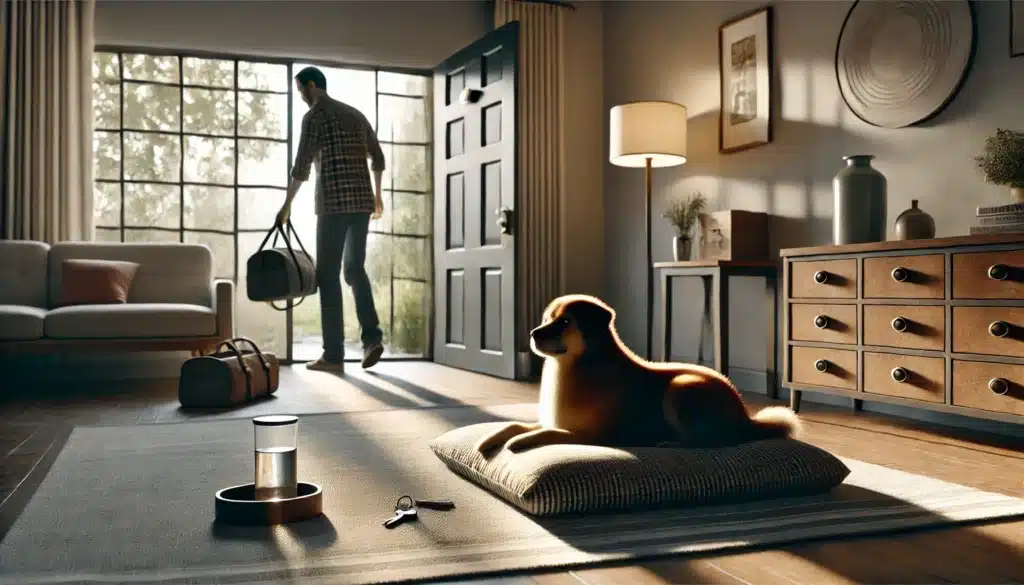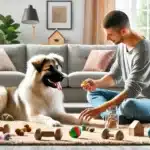No matter how much we love our dogs, it’s not always possible to be home with them 24/7. Whether it’s work, errands, or a night out, there will be times when your dog needs to stay home alone. While some dogs handle solitude just fine, others can become anxious, bored, or even destructive if left without preparation.
In this guide, you’ll learn how to safely and confidently leave your dog home alone, create a stress-free environment, and support your dog’s emotional well-being—even when you’re not around.
Is Your Dog Ready to Be Left Alone?
Before leaving your dog alone for extended periods, consider:
- Age: Puppies under 6 months shouldn’t be left alone for more than 2–3 hours.
- Potty Training: Dogs who aren’t fully house-trained may need supervision or a structured containment space.
- Separation Anxiety: Does your dog bark excessively, pace, or become destructive when alone?
- Energy Level: High-energy dogs need exercise before alone time to reduce restlessness.
If your dog struggles with being alone, start small and build up gradually.
Step 1: Set Up a Safe and Comfortable Space
Your dog needs a secure, quiet, and familiar environment when you’re not home.
Options:
- Crate: Great for dogs already crate-trained. It provides comfort, structure, and prevents access to dangerous items.
- Playpen: Offers more space than a crate while still limiting access.
- Dog-proofed room: A small area like the kitchen or laundry room, cleared of hazards.
Add:
- A comfy bed or blanket
- A few favorite toys
- Access to water (non-spill bowl or dispenser)
- Soft lighting or white noise (optional)
Avoid giving access to the entire house unless your dog has proven they’re trustworthy.
Step 2: Provide Mental Stimulation
One of the biggest causes of destructive behavior during alone time is boredom.
Ideas to keep your dog busy:
- Puzzle toys filled with treats or kibble
- Frozen Kongs with peanut butter or wet food
- Lick mats (can be frozen for longer use)
- Interactive feeders
- A safe chew toy to satisfy the need to gnaw
Rotate toys regularly so your dog doesn’t get bored.
Step 3: Create a Calm Exit Routine
How you leave the house can shape your dog’s entire experience while you’re gone.
Do:
- Stay calm and casual — avoid big goodbyes
- Give your dog a treat or toy just before leaving
- Practice “settle” cues or calm behavior before exit
- Use the same phrase every time, like “I’ll be back” or “Be good”
Don’t:
- Make a big fuss or show anxiety
- Sneak out (this can confuse and stress your dog)
Consistency and predictability are key to reducing stress.
Step 4: Start Small and Build Duration
If your dog isn’t used to being alone, don’t go from 0 to 8 hours.
Gradual independence plan:
- Step outside for 5–10 minutes, then return calmly.
- Increase time away over a few days or weeks.
- Use a camera to observe behavior when you’re gone.
- Return only when your dog is calm—avoid reinforcing anxious behavior.
Practice makes independence more manageable.
Step 5: Use Technology to Stay Connected
Modern tools can help you monitor and support your dog from afar.
Consider:
- Pet cameras: Watch and talk to your dog remotely (e.g., Furbo, Petcube)
- Automatic treat dispensers
- Soothing music or white noise machines
- Timed lights for comfort in the evening
This helps ease your mind and provides comfort to your dog as well.
Step 6: Arrange for Help When Needed
If you’ll be away for a long stretch, don’t leave your dog alone all day.
Alternatives:
- Ask a friend, neighbor, or family member to check in
- Hire a dog walker or pet sitter
- Try doggy daycare once or twice a week for socialization and exercise
- Split the time with another pet owner (e.g., alternating check-ins)
Breaks during the day reduce stress and provide much-needed interaction.
Step 7: Watch for Warning Signs
Leaving dogs alone should not cause emotional distress. Look for signs of trouble:
- Excessive barking or howling
- Accidents in the house
- Destroyed furniture, doors, or blinds
- Drooling, pacing, or trembling
- Refusal to eat when alone
These can indicate separation anxiety, which may require professional support from a vet or dog behaviorist.
Bonus Tips for a Smooth Solo Experience
- Leave behind a piece of clothing with your scent
- Keep arrival and departure low-key
- Avoid punishing accidents — instead, reassess duration or enrichment
- Stick to a consistent routine, including walks and meals
- Give your dog plenty of exercise before you leave
A tired dog is a calmer dog!
Final Thoughts: Alone Time Shouldn’t Feel Lonely
Learning to be alone is an important life skill for dogs. With the right setup, stimulation, and routine, your dog can feel safe and relaxed—even when you’re not there.
By planning ahead, introducing solo time gradually, and making their environment calm and rewarding, you’ll help your dog build confidence, reduce stress, and stay happy when home alone.
Because when your dog knows you’ll always come back, they’ll feel secure enough to enjoy a little peace and quiet.







